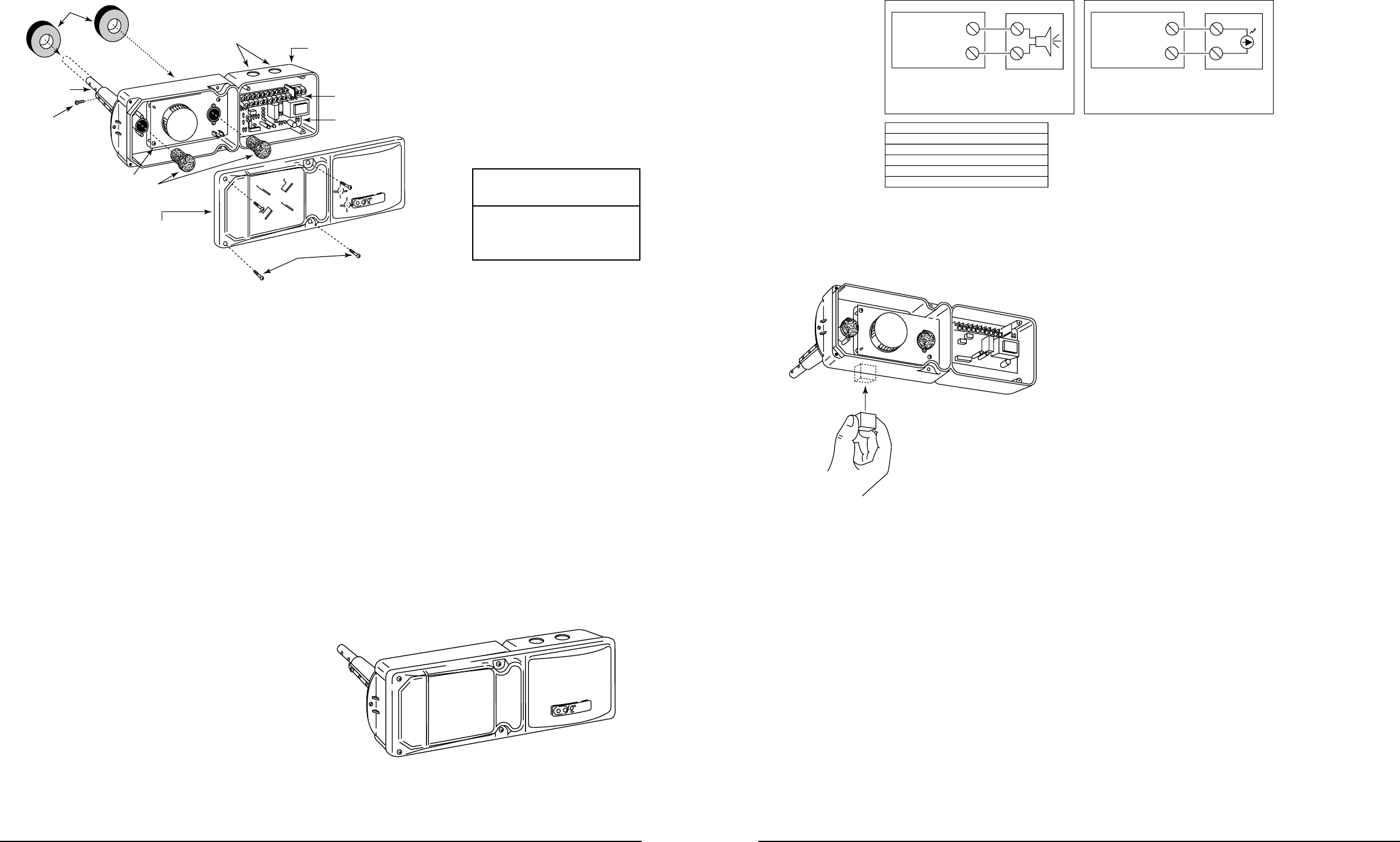
[4] Contents Of The Duct Smoke Detector Kit
1. Complete housing base and cover assembly
2. Two #10 machine screws for mounting
3. Two sampling tube filters
4. One test magnet
5. Drilling template
6. Two foam gaskets
7. Four #6-self tapping mounting screws for the metal
sampling tube and optional exhaust tube extension
8. Two jack nuts
9. One inlet tube end plug
10. One telescoping sampling tube
11. One #8 self-tapping screw for the telescoping sampling
tube
NOTE: For ducts over 1
1
/2 feet, longer inlet sampling tubes
must be ordered to complete the installation. They
must be the correct length for the width of the duct
where they will be installed. See Table 1 on page 3
to determine the inlet tube required for different
duct widths.
[5] Installation Sequence
[5.1] Verify Duct Air Flow Direction And Velocity
Model DH100ACDC detectors are designed to be used in air
handling systems having air velocities of 500 to 4000 feet
per minute. Be sure to check engineering specifications to
ensure that the air velocity in the duct falls within these pa-
rameters. If necessary, use a velocity meter to check the air
velocity in the duct.
[5.2] Drill The Mounting Holes
Remove the paper backing from the mounting template
supplied. Affix the template to the duct at the desired
mounting location. Make sure the template lies flat and
smooth on the duct. Center punch holes A and B. Drill the
holes as indicated on the template. Insert the two jack nut
receptacles. Drive a #10 machine screw into jacket to flare
the retainer, then back out the screw to use for detector
mounting.
[5.2.1] Sampling Tube Installation for Ducts Less
Than 1
1
/2 Feet Wide (see Figure 2)
1. Remove the front cover.
2. Use the tube installation chart above to determine the
set screw setting.
3. Slide the sampling tube into the housing bushing.
4. Align the holes in the bushing with the holes in the
sampling tube. Make sure the number of exposed holes
on the supplemental tube matches the number as deter-
mined in step 2. Secure with the #8 self-tapping screw
into the bottom of the permanent tube.
NOTE: For ducts greater than 1
1
/2 feet in width, refer to
sections [5.4.1] and [5.4.2].
Figure 2. Sampling tube connected to duct smoke
detector:
[5.3] Secure The Detector Housing To The Duct
Slide the foam gaskets over the tube bushings as shown in
Figure 3. Use the two machine screws to screw the detector
D100-68-00 2 I56-1147-07
[3] Figure 1: Exploded View Of Duct Smoke Detector Components
FOAM
GASKETS
TELESCOPING TUBE
CONDUIT HOLES
DETECTOR
HOUSING
TERMINAL STRIP
DETECTOR
COVER
SAMPLING TUBE
FILTERS
COVER MOUNTING
SCREWS
TELESCOPING TUBE
SELF-TAPPING SCREW
POWER BOARD
DETECTOR BOARD
Tube Installation Chart:
Supplemental Duct
Tube Holes Width
512″-14″
614″-16″
716″-18″
D100-68-00 7 I56-1147-07
Figure 11. Testing detector alarm:
A78-2325-00
[6.2.2.2] RTS451/RTS451KEY Remote Test Station
The RTS451/RTS451KEY Remote Test Station facilitates
test of the alarm capability of the duct smoke detector
as indicated in the RTS451/RTS451KEY manual. The
DH100ACDC duct smoke detector can be reset by the
RTS451/RTS451KEY. If a system control panel is used,
the panel itself may also require testing.
To install the RTS451/RTS451KEY, connect the device as
shown in Figure 9; wire runs must be limited to 25 ohms or
less per interconnecting wire.
[6.2.3] Sensitivity Tests
[6.2.3.1] MOD400 or MOD400R Test
After verification of alarm capability, use the MOD400R test
module with a voltmeter to check detector sensitivity as in-
dicated in the test module’s manual. The housing cover
must be removed to perform this test.
If test module readings indicate that the detector head is
outside of the acceptable range that is printed on the label
of the detector, the detector chamber requires cleaning per
Section [7] of this manual.
[7] Detector Cleaning Procedures
Notify the proper authorities that the smoke detector sys-
tem is undergoing maintenance, and that the system will
temporarily be out of service. Disable the zone or system
undergoing maintenance to prevent unwanted alarms and
possible dispatch of the fire department.
[7.1] Air Filters
1. Turn off power to the system.
2. Remove and inspect sampling tube filters.
3. If filters are heavily coated with dirt, replace them with
new filters. If they are not heavily coated, use a vacuum
cleaner or compressed air nozzle to remove dust, then
reinstall the filters.
[7.2] Photo Detector Boards
1. Remove the screen by gently grasping on each side and
pulling straight off.
2. Lift the photo chamber in the same fashion. Vacuum the
screen and cover. Use clean, compressed air to loosen
and blow out any remaining debris. Replacement
screens (S08-39-01) are available.
3. Vacuum photo chamber, then use clean compressed air
to blow area clean.
4. Replace the chamber by pressing it onto the base.
Press the screen into place. It should fit tightly on the
chamber.
[7.3] Ion Detector Boards
1. Brush or vacuum inside area of cover. Chamber may
then be blown out using clean, compressed air.
ALARM SIGNAL (+)
AUX POWER (–)
15
20
(+)
(–)
DUCT DETECTOR
DH100ACDC
PA400 (OPTIONAL)
AUDIBLE ALERT
ALARM SIGNAL (+)
AUX POWER (–)
15
20
(+)
(–)
DUCT DETECTOR
DH100ACDC
RA400Z (OPTIONAL)
REMOTE (LED)
ANNUNCIATOR
RED
ACCESSORY CURRENT LOADS AT 24 VDC
DEVICE
APA451
PA400
RA400Z
RTS451/RTS451KEY
STANDBY
12.5mA Max.
0mA
0mA
12mA Max.
ALARM
30mA Max.
15mA Max.
10mA Max.
7.5mA Max.
When a unit is powered at the 120VAC or 220/240VAC input,
any combination of accessories may be used such that the given
accessory loads are:
60mA or less in the standby state,
110mA or less in the alarm state.
Figure 10. Wiring diagrams for optional accessories (see page 6 for APA451 wiring diagram):
A78-2354-05






